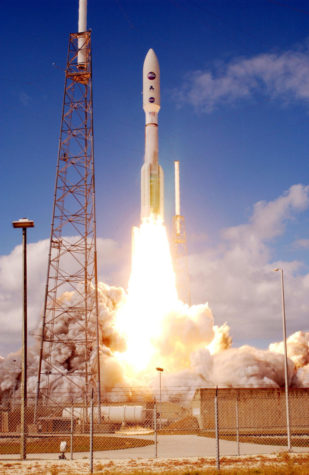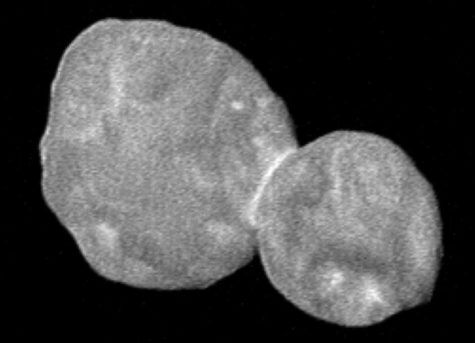Expanding Our Horizons on Ultima Thule: Full Version
On Jan 1, 2019, the New Horizons spacecraft made a 2,200-mile flyby of a Kuiper Belt Object (KBO) called (486958) 2014 MU69, nicknamed “Ultima Thule.” The flyby was the farthest flyby of any object by a human-made spacecraft.

The New Horizons spacecraft was launched from Space Launch Complex-41 at Cape Canaveral Air Force Station in Florida on Jan. 19, 2006. The spacecraft was launched on an Atlas V 551. The Atlas V was chosen because New Horizons has a Radioisotope Thermoelectric Generator (RTG) that contains plutonium. Lockheed-Martin’s Atlas V was and is the only American rocket qualified to launch a spacecraft with nuclear materials. The Atlas V has high probability for launching on schedule, which is critical for interplanetary missions. Also, launching the spacecraft on another launch vehicle like United Launch Alliance’s Delta-IV would require more money, paperwork and more importantly, a more uncertain launch window. Launching a day after the window closes would have meant an additional three years for the mission to Pluto, an extension NASA was not guaranteed to fund.
The Atlas V rocket first stage is powered by two Russian RD-180 engines. The first stage also had five stap-on solid rocket boosters attached to it. The Centaur upper stage, above the first stage was powered by one single RL-10 engine. On top of the Centaur upper stage was the Boeing Star-38 solid rocket third stage, which propelled the New Horizons spacecraft farther than the moon in only nine hours. After that, the third stage separated and New Horizons was on its own, traveling faster than any previous spacecraft had left Earth until NASA’s Solar Parker Probe in 2018.
New Horizons had to be built to fit inside the payload fairing on the Atlas V. The spacecraft is smaller and much more compact than the Voyagers built by NASA’s Jet Propulsion Laboratory. New Horizons was built by the Johns Hopkins Applied Physics Laboratory, which also built NASA’s Solar Parker Probe.
New Horizons is in the shape of a triangle, with the science experiments at the wider end and the RTGs at the tip of the spacecraft. In the middle of the spacecraft is the High-Gain antenna, along with the Medium and Low-Gain antennas. The High-Gain antenna is a 2.6-meter dish structure that sends and receives signals when the spacecraft is millions of miles from Earth.
Because New Horizons points its instruments by orienting the whole spacecraft, it cannot communicate using the High Gain Antenna or the Medium Gain Antenna and take scientific data at the same time. So, the spacecraft stores the scientific data it collects on its computer until it can downlink the data to NASA’s Deep Space Network (DSN). New Horizons can downlink data (send data back to Earth) at ~1000 bits per second.
Gold colored Kapton covers the spacecraft to provide thermal protection. According to Johns Hopkins Applied Physics Laboratory, the Kapton keeps the spacecraft at a temperature of “between 10 and 30 degrees Celsius (about 50-85 degrees Fahrenheit)”, around room temperature. Kapton “has extremely low absorptivity and emissivity” meaning it absorbs very little of any light falling on it, and radiates away very little of the heat from inside.
Some of the scientific experiments on board New Horizons include: Ralph, Pluto Energetic Particle Spectrometer Science Investigation (PEPPSI), Solar Wind at Pluto (SWAP), LOng Range Reconnaissance Imager (LORRI), and Alice. Ralph and Alice are named after Ralph and Alice Kramden from a 1950’s era sitcom.
Ralph is a “Time Delay Integration” imager with six arrays. According to a source familiar with Ralph, it has a 5.7-degree field of view and can create unlimited length images in four scientific colors and black and white. It also has a 5.7 degree monochromatic “framing” camera for navigation, like a normal camera but wide in one direction and skinny in the other. Lastly, it has an imaging infrared spectrometer, the Lisa Hardaway Composition Mapper, named after one of the engineers who built it. The LHCM makes a map of infrared spectrums, from 1.25 to 2.5 microns, infrared light beyond the range of human vision, from which chemical compositions and temperatures can be determined. Ralph gets very cold, about 180 Kelvin or -136 F. According to the same source, Ralph is “made entirely of aluminum, including the mirrors, and stays focused as it cools. The infrared detector gets down below 100 Kelvin,” or -280 degrees Fahrenheit. Ralph operates using only seven watts.
The objective for the mission was to make a flyby of Pluto. After it’s Jupiter encounter, where it picked up speed to three kilometers per second, New Horizons went into hibernation mode until it got closer to Pluto. The operators at the Johns Hopkins Applied Physics Laboratory in Laurel, MD would wake it every year or so to check its health and update software.
Even with many practice runs in deep space, the spacecraft entered safe-mode after a software glitch just a week before the Pluto encounter. However, the issue was solved just in time for the Pluto flyby, when on July 14, 2015, New Horizons made its closest approach to Pluto. Images and measurements of Pluto, its giant moon Charon, and its four smaller moons Nix, Hydra, Styx, and Kerberos are a wealth of scientific data that the team scientists will use for years to make discoveries and rewrite the textbooks.
Ultima Thule was chosen for the encounter not long after the Pluto flyby in 2015. In the following November, controllers at the Johns Hopkins Applied Physics Laboratory ordered the spacecraft to alter its trajectory by only a mere ¼ of a degree. The spacecraft performed the maneuver using its little hydrazine thrusters.
New Horizons has few moving parts because no mechanical parts are qualified to work for a more than ten-year mission. The thrusters are mounted so that they have the most accuracy possible, where each tiny puff out of the hydrazine thrusters makes a very fine pointing adjustment.
The Kuiper Belt is a ring of small objects outside of the orbit of Neptune. It was unknown until the end of the 20th century, but more than a thousand Kuiper Belt Objects (KBOs) have been discovered since 1992. Pluto is thought to be a KBO brought “close”, three billion miles from Earth, by the gravity of Neptune, and is the largest KBO discovered to date. Ultima Thule is the first KBO to be visited by a spacecraft, and no other KBO missions are yet planned.
New Horizons screamed past Ultima Thule in on New Year’s Day, 2019 and made its closest approach at 12:33 A.M. EST. According to the Johns Hopkins Applied Physics Laboratory (JHAPL), the spacecraft minimum distance was only 3,500 km or 2,200 miles.

Because New Horizons cannot take images and communicate with Earth at the same time, the JHUAPL team had to wait until late morning on Jan. 1 to get confirmation that New Horizons had survived the encounter and was safe. In mission control, the Mission Operations Manager, nicknamed MOM, confirmed that the spacecraft was safe when she said, “RF Green” which meant that the spacecraft was healthy and transmitting data. Later stating “the CDH pointer is exactly where we anticipated” meant that the spacecraft had taken and recorded 100% of the photos and data it was programmed for. If something was wrong, autonomy software would have kicked in to mediate the issue, which could have resulted in less data.
While the spacecraft downlinks the data from the Ultima Thule encounter, the it continues to spin like a top while pointing at Earth. However, while New Horizons transited the Sun, (going behind it) a week after the encounter, communications were blocked temporarily. Now out from behind the Sun, New Horizons is again in communications with Earth, although it will take almost two years to downlink all its encounter data and photographs.


